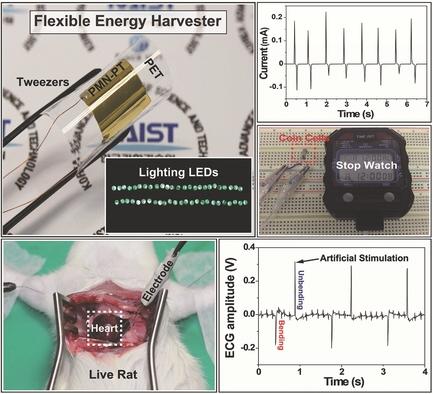Jun 24 2014
Small Energy
 Energy is what makes stuff happen. The ability to generate energy in useful amounts and locations is key to our civilization. Often when discussing energy we are focusing on big energy, how to make large amounts of energy in a cost-effective manner with minimal negative impact on our environment.
Energy is what makes stuff happen. The ability to generate energy in useful amounts and locations is key to our civilization. Often when discussing energy we are focusing on big energy, how to make large amounts of energy in a cost-effective manner with minimal negative impact on our environment.
The ability to generate tiny amounts of energy is also useful, however. One particular application requiring a small but reliable source of energy is implantable devices, such as cardiac pacemakers. Right now pacemakers are run by small batteries. These batteries have a limited lifespan, and need to be surgically replaced.
What if, however, we could generate the required electrical energy from the body itself. Our bodies use a relative large amount of energy, creating movement, electrical signals, generating heat, assembling proteins and cells, and undergoing biochemical reactions. All we would need to do is tap into a tiny slice of this energy and there would be enough energy to power a pacemaker, or many other small implantable devices.
A recent paper discusses a successful demonstration of one such technology. Hwang et. al. report:
A flexible single crystalline PMN-PT piezoelectric energy harvester is demonstrated to achieve a self-powered artificial cardiac pacemaker. The energy harvesting device generates a short-circuit current of 0.223 mA and an open-circuit voltage of 8.2 V, which are enough to meet the standard for not only charging commercial batteries but also stimulating heart without an external power source.
The piezoelectric effect is a property of some materials that converts mechanical stress into electrical current. In the body, mechanical stress can derive from the beating of the heart, the movement of the chest wall in breathing, the movement of limbs, or the bouncing movement of walking. The idea of harvesting electricity from such movement through the piezoelectric effect has been around for a while, and it’s good to see a successful demonstration of this principle.
Other types of devices that could benefit from this technology include hearing aids, medication pumps, vagal nerve or deep-brain stimulators, and implantable sensors (such as blood glucose monitors).
The technology could also be used for wearable or portable electronic devices. Flexible piezoelectric devices could provide extra juice to your cell phone, extending the life of its charge, or even providing an emergency charge if you are away from an outlet.
It’s likely that the technology would also give a boost to the development of new wearable electronics applications. A major limitation of such technology is providing convenient power.
There are other technologies for harvesting electrical energy. Electromagnetic generators harvest kinetic energy by creating relative motion between a conductor and a magnetic flux to induce charge in the conductor. For at least 20 years there have been kinetic watches that use the movement of the arm to wind the mainspring. Now, there are watches that use the same motion to power electromagnetic generators for a quartz crystal mechanism.
There is also the thermoelectric effect – materials that generate an electric current when there is a temperature difference between the two sides. Electrons will flow from the hot side to the cold side, which can be harvested as an electric current.
The pyroelectric effect is similar, but involves materials that will generate a voltage due to a change in temperature. To clarify the distinction – thermoelectric effects result from a temperature difference between one side and the other of the material, while pyroelectric effects result from a change in the temperature of the entire crystal. The latter generates a voltage difference across the crystal, which can be used to general a small current.
Of course, small photovoltaics can be used for external devices. Photovoltaics convert sunlight into electrical current.
It is possible to harvest other types of ambient energy, such as radio waves, which are fairly ubiquitous in our modern world. This is currently not a very efficient method, but could provide small amounts of energy to implantable devices, or devices that would otherwise be inaccessible.
For implantable devices it is theoretically possible to function like any other part of the body and derive power from glucose through oxidation. These are called biofuel cells. They can use bacteria to consume the glucose, or simply duplicate the necessary chemical reactions.
Conclusion
There are multiple technologies being developed to generate tiny amounts of electrical energy to power small devices – implantable, wearable, or inaccessible. The development of such technology could revolutionize our use of such devices, or at least make them much more convenient.
Of potential methods of harvesting ambient or otherwise wasted energy, harvesting kinetic energy through magnetic induction or piezoelectric effects seems to be the most mature. This latest study demonstrates a piezoelectric device capable of powering an implanted pacemaker – a significant milestone.
It’s always difficult to predict the development of cutting edge technology, but these technologies do seem ripe. I have been reading about such effects and their potential for decades, and now it seems we are crossing the threshold to a significant increase in actual applications.
We might be entering the age of small energy.






